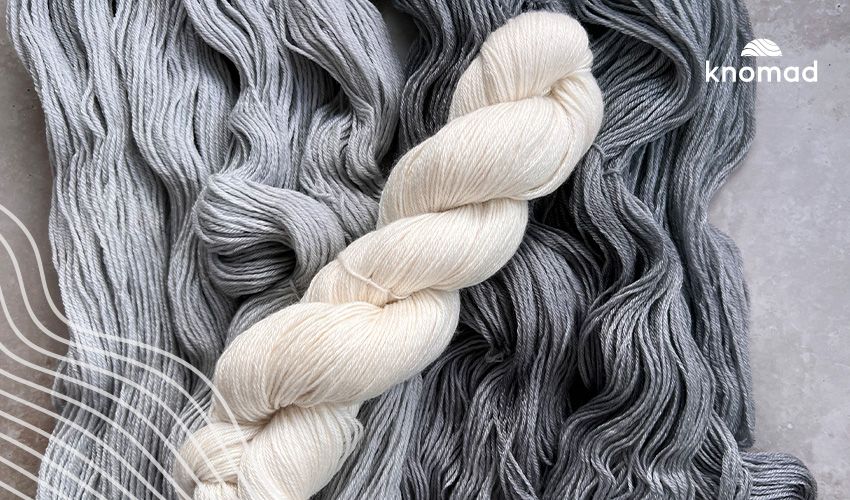How to Dye a Gradient with Knomad ASPERITAS Yarn
Our ASPERITAS yarn is a unique blend of 50% recycled wool and 50% tencel. The sustainable, recycled wool takes dye easily, while the plant-based tencel requires a different dye process to absorb any color. This means that once ASPERITAS is dyed, it has a heather appearance, because the wool in the blend absorbs the dye, while
the tencel does not. It’s a thrill to be able to achieve this rustic appearance in a yarn simply by dyeing it a semi solid color.
We love that the yarn resembles shades of denim when tinted with indigo colored dye. To show off this easy heather effect, we thought we’d dye the yarn 5 shades of the same blue to create a subtle gradient. Today we will show you how to dye an easy 5 skein gradient with ASPERITAS yarn and just one color of dye.
Materials
- 5 skeins of Knomad ASPERITAS, 50% recycled wool, 50% tencel, 100 grams, 383 yards each Powder dye for protein fibres. We used Dharma Trading co silk and wool dye in the color Indigo.
- Gram scale that measures to at least 2 decimal points. We will be weighing out dye in very small quantities, like .25 grams, so precision is important here.
- Citric acid powder
- 5 cups for mixing dye. We used plastic cups. You can use reusable cups, as long as you only use them for mixing dye and not for drinking.
- A spoon for mixing
- Gloves to protect your hands when handling the yarn and dye.
- Your regular set up for heat setting, rinsing and drying yarn. We used a hotel pan placed over a gas burner.
- Tape and a marker (Optional, for labeling your dye cups)
- Zip ties or shower curtain rings (Optional, helps to keep the yarn from tangling while dyeing)
Soak the Yarn
Put a zip tie around each skein of yarn, if you choose to use them. Soak the yarn in lukewarm water and a spoonful of citric acid for about an hour. Weigh and Mix the Dye While the yarn soaks, we will measure the dye. We will weigh the amount of dye needed for one skein into one cup of dye. At this point, you may want to label each cup with the amount of dye you are about to put in. To weigh the dye, place the cup on the scale and press TARE. The scale should display 0. Slowly add powder dye to the cup until desired weight is reached (refer to the table below for the exact dye weights we used). Set aside and repeat until you have measured out the dye into each cup. We measured this much dye into each cup:
- .25 grams
- .5 grams
- .75 grams
- 1 gram
- 1.25 grams
Add about ¼ teaspoon citric acid to each cup. Fill each cup with hot water until about ¾ full.
Dye the Yarn
Pour the contents of one cup into the pot you will use the dye the yarn. It is not important to go in order of concentration, but if you want to do so, we recommend starting with the lightest color (lowest concentration) and working up to the darkest color (highest concentration). We dyed in a hotel pan like you might see a caterer use. Add water to the pan until there is enough liquid in the pan to cover one skein of yarn. Stir well. Add one presoaked skein of yarn to the cold pan. Using gloved hands or a spoon, massage the yarn lightly to work the color evenly into the
yarn. Cover the pan and heat the yarn until it has absorbed all the dye and the water is clear. This should take about 10 minutes. Use low heat and be careful not to scorch the yarn. It is better for the yarn to heat it slowly and for a longer amount of time than to cook it hot and quickly as this could cause the yarn to burn. When in doubt, go low and slow! Repeat this process with each skein of yarn.
Rinse the Yarn
Allow the yarn to cool completely. Rinse the yarn as you normally would. Allow the yarn to dry.
Tags: asperitas, Beginners, Hand dyers, indie dyers















I am excited about this yarn. I use natural derived dyes only, after seeing your results I think I will go with oak and walnut to get some natural heathery earth tones. The tannins will help act as mordant for the wool. Looking forward to this dye.
-Christine at thedarlingyarncompany.com